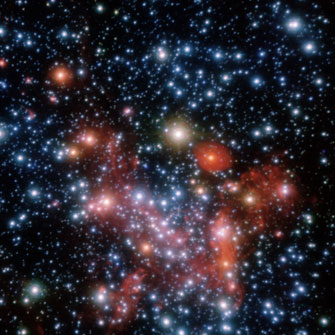Origins of Massive Young Stars orbiting the Supermassive Black Hole at the Centre of the Milky Way
 Fabio Antonini of the Canadian Institute for Theoretical Astrophysics and David Merritt of the Rochester Institute of Technology have developed a new theory that explains the orbits of the massive young stars that closely orbit the black hole at the centre of the Milky Way.
Fabio Antonini of the Canadian Institute for Theoretical Astrophysics and David Merritt of the Rochester Institute of Technology have developed a new theory that explains the orbits of the massive young stars that closely orbit the black hole at the centre of the Milky Way.
The discovery of these stars called “S-stars” in recent years has provided an unprecedented opportunity for studying the black hole at the Galactic centre itself, but it also raised new questions because these massive young stars were orbiting in a region too violent for them to have formed there, implying that they had to have migrated from further out.
When theoreticians produced models explaining the migration of the S-stars toward the centre, the observed orbits didn’t match the models.
Dr. Antonini is offering the best answers to date for this puzzle in his Thursday afternoon talk at the annual meeting of the Canadian Astronomical Society (CASCA). In “The origin of the S-star cluster at the Galactic Centre”, Antonini is presenting a unified theory for the origin and dynamics of the S-stars.
Explaining how these stars managed to get so close in only tens of millions of years since they formed has been a challenge. “Theories exist for how migration from larger distances has occurred, but have up until now been unable to convincingly explain why the S-stars orbit the Galactic centre the way they do”, Antonini said. “As main-sequence stars, the S-stars can not be older than about 100 million years, yet their orbital distribution appears to be ‘relaxed’, contrary to the predictions of models for their origin”.
Antonini and Merritt’s model suggests that the S-stars attained the orbital shapes astronomers have observed by interacting gravitationally with other stars near the central black hole. Their research builds on new insights on how stellar orbits at the Galactic centre evolve due to the joint effect of gravitational interactions with other stars and the super massive black hole.
Merritt says “Theoretical modeling of S-star orbits is a means to constrain their origin, to probe the dynamical mechanisms of the region near the Galactic centre and indirectly to learn about the density and number of unseen objects in this region”.
Supermassive black holes are believed to inhabit the centre of most, if not all, massive galaxies. How they form and grow is intimately connected to the formation of the galaxies they inhabit. The black hole in the centre of our own Galaxy, named Sgr A* (pronounced Sagittarius A-star), is the closest and most extensively studied example. By tracking the orbits of the S-stars over the past several years, astronomers have been able to conclusively show that the object they orbit is indeed a supermassive black hole.
The CASCA annual meeting is being hosted at the University of British Columbia, in Vancouver, BC May 28 – 30. Dr. Antonini is among a dozen CITA faculty, post-doctoral fellows and national fellows giving talks at the meeting.
Model of the Orbits of Stars at the Galactic Centre- Data by Andrea Ghez and Sylvana Yelda, UCLA using the Keck Telescopes. Visualization by Stuart Levy and Robert Patterson, NCSA
CASCA Annual Meeting 2013 Program